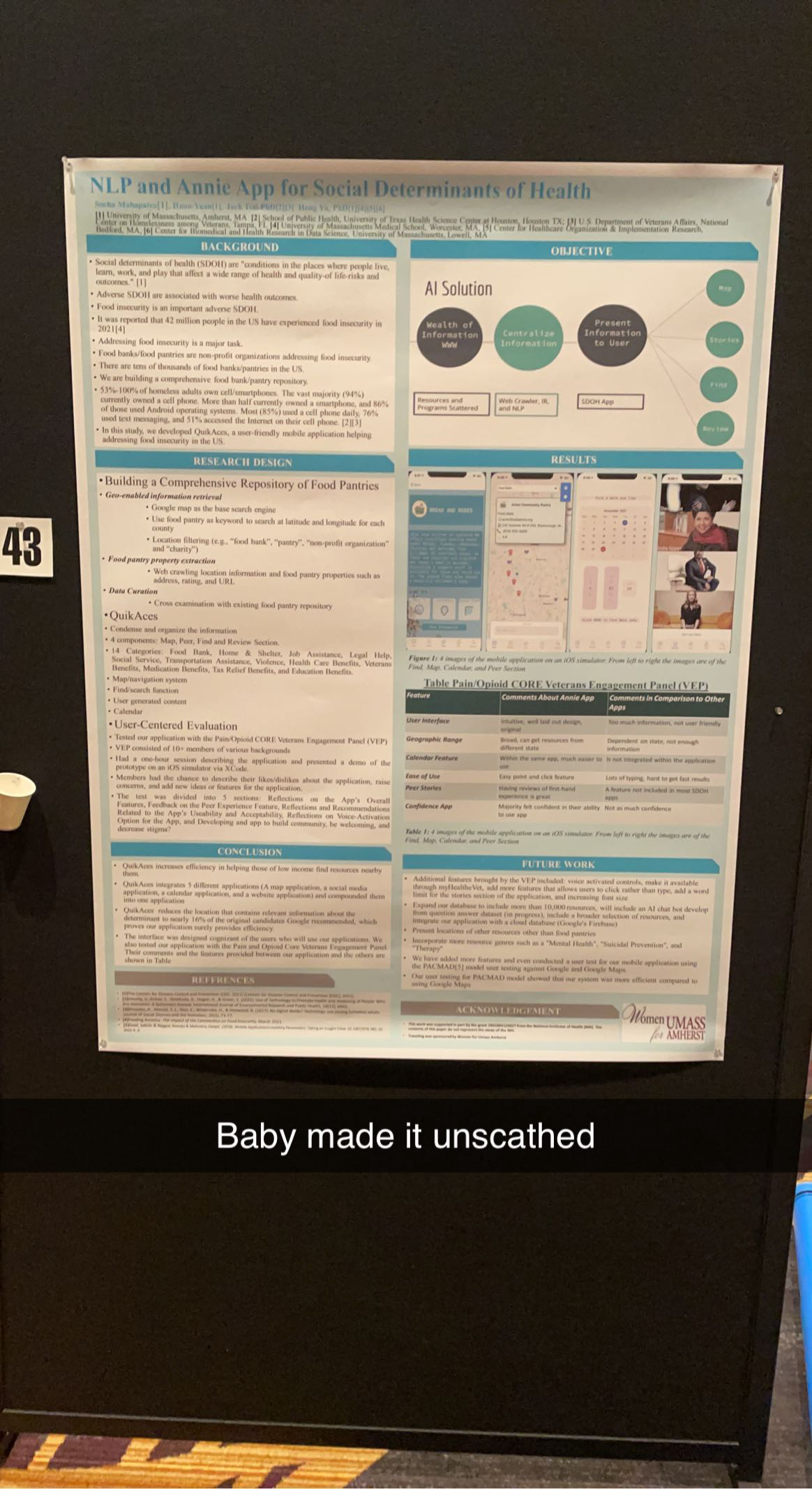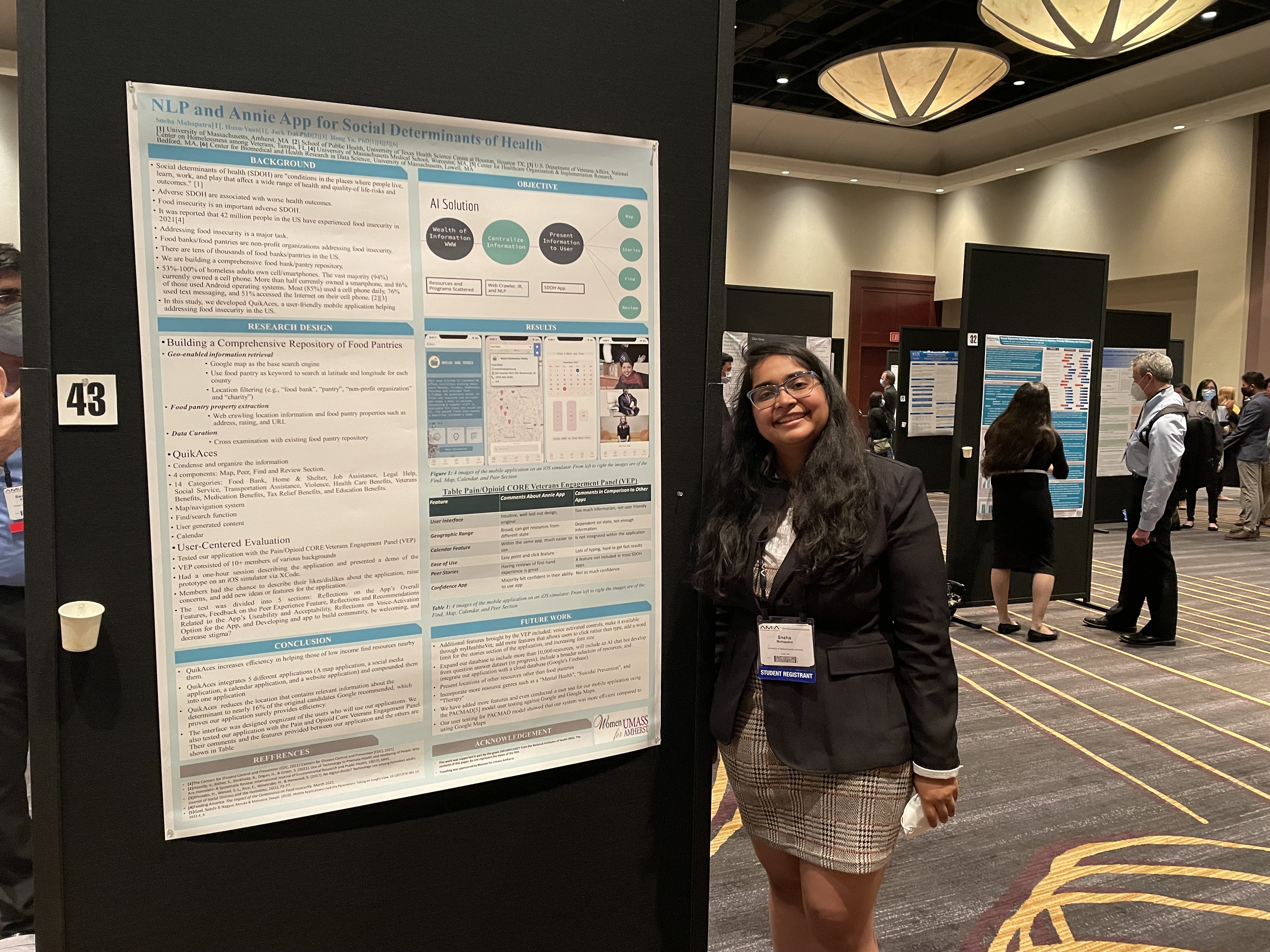AMIA
Published:
“Eventually, doctors will adopt AI and algorithms as their work partners. This leveling of the medical knowledge landscape will ultimately lead to a new premium: to find and train doctors who have the highest level of emotional intelligence.”- Eric Topol
AMIA 2022
About
When joining Umass Amherst, I was lucky to join a research group as a Master research student. The research group, Biomedical Informatics Natural Language Processing, aka BioNLP, is led by Professor Hong. The group uses Natural Language Processing to aid and advance medical techologies and methods. Specifically, my research project is QuikAces: developing a mobile application to help those of low income find food pantries. The abstract is listed in the section below. My team and I published our abstract to the AMIA conference (American Medical Informatics Association). According to AMIA they are “a community committed to the vision of a world where informatics transforms people’s care. Over the last 35 years, the use of informatics has grown exponentially to improve health and to make better healthcare decisions. Today, informatics is the key to accelerating the current goals of healthcare reform.
Every day millions of people benefit from informaticians’ ability to accelerate healthcare’s transformation by collecting, analyzing and applying data directly to care decisions. Data produced throughout health and healthcare is the driving force of informatics and its ability to innovate critical advancements that directly benefit people. AMIA’s members are critical to discovering these insights, which is why AMIA is committed to being the professional home for the informaticians of today and the driver of informatics’ future.”

Abstract
There are people that are in need of social resources and programs that can aid them with Finances, Health Care, Food Insecurity, etc. When one does a quick Google search we can see that there are a plethora of different programs available. Not many people know that these resources exist and the amount of information is overwhelming. Therefore, sifting through all the information to find a tailored program, or a resource that fits a certain individual is difficult. Furthermore, not everyone has access to this technology or understands how to look for resources themselves. We decided that building a Social Determinants of health (or SDOH) app would be the best way to solve this problem. And after consulting with different groups and panels such as the Homeless Veterans Engagement Panel, they seemed enthused as well. With this wealth of information, which are the resources and programs scattered across the internet, we need to be able to extract and centralize this information (which we will be using a web crawler and NLP for). And then, once the information is centralized and analyzed, we can present the information to the user in an intuitive manner in the form of a mobile SDOH application. The Application consists of 4 main components which are Mapping, Stories, Finding, and Reviews.

My Research
New Research
This year, the conference was held at the Royal Sonesta in Houston, Texas. The conference was from May 24th-26th, however due to a family trip I was late on the 24th day and I unfortunately missed a workshop. However, if you ever visit a conference I suggest going to the workshops they provide. It will give you a chance to network with others and also learn something new in research world. Towards the evening of the 24th day, I attended a meeting called women in AMIA. It was a chance to network with women who are part of the AMIA world. I talked to different people who worked in various fields and were at different stages in their career. I talked to physicans, data scientistcs, computer science students, and many more. Attending conferences such as these that have people of many backgrounds is a great way to learn new information and see how others view each field and how they integrate them in their own line of work. I was surprised to learn that many physicians are taking machine learning and data science courses. This is necessary however, because as we start integrating this topics in the medical world, it is imperative for the people using this technology to understand how it works. Otherwise it is considered a breach in ethics.
During the 25th day, I attend all sorts of talks from the morining until I had to give my presentation in the afternoon. The talk that caught my attention was “Predicting Risk of Progression to Severe Covid-19th in Southwestern Pennsylvania: A Two-Year Journey” by Helen Zhou, Kelly J Shields, Cheng Cheng, Gursimran Kochhar, Tariq Cheema, Zachary C. Lipton and Jeremy C. Weiss. The presenter, Helen Zhou, spoke about how she and her team developed a machine learning model to track the progression of becoming infected with the COVID-19 virus. Zhou also spoke about the durability of her model and how it is able to perform well despite having two years pass. This is critical in the machine learning world. It is great to have a model work now and give an accurate score, how well does the model hold up 10 years down the line? Even if it works great now, it needs to be able to produce the same quality afterwards, otherwise it is not productionable.

Conclusion
Presenting at the conference was an amazing experience. Although my career path is heading away from the academia world, it is great learning about these experiences and I hope there is more to come!

Leave a Comment